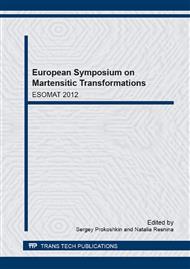p.456
p.461
p.468
p.473
p.481
p.486
p.491
p.496
p.501
Mechanocyclic and Time Stability of the Loading-Unloading Diagram Parameters of Nanostructured Ti-Nb-Ta and Ti-Nb-Zr SMA
Abstract:
The Ti-21.8Nb-6Zr and Ti-19.7Nb-5.8Ta (at.%) shape memory alloys are thermomechanically treated by cold drawing and post-deformation annealing at 550-600°C forming a nanosubgrained structure in the β-phase. Cyclic mechanical testing using a “loading-unloading” mode with 2% tensile strain in each half-cycle reveals the non-perfect superelastic behavior of both alloys during the very first cycles of testing, which becomes perfect during further mechanocycling. The Young’s modulus of thermomechanically-treated alloys is low (about 45 GPa), and it decreases during mechanocycling (n=10 cycles) down to 25-35 GPa, approaching the Young’s modulus of cortical bone tissues. The Young’s modulus obtained in the 10th cycle is stable or changes only slightly during a further 40-day pause at room temperature and then during repeated mechanocycling. The residual strain per cycle, the transformation yield stress and the mechanical hysteresis decrease during mechanocycling. Subsequent to a 40-day pause at room temperature, they restore their initial values. Repeated mechanocycling is accompanied by a repeated decrease of these parameters.
Info:
Periodical:
Pages:
481-485
Citation:
Online since:
January 2013
Price:
Сopyright:
© 2013 Trans Tech Publications Ltd. All Rights Reserved
Share:
Citation:


